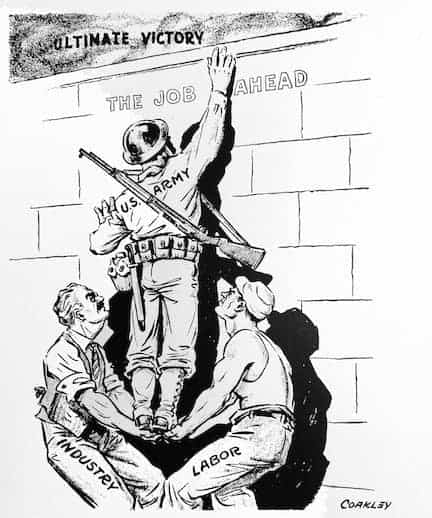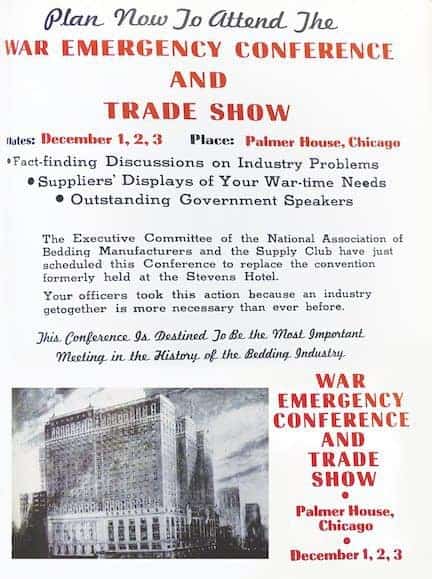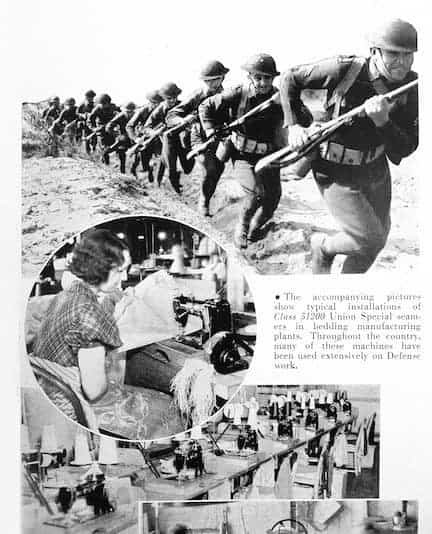Part I of the second installment on the International Sleep Products Association’s first 100 years.
Bedding makers join forces to combat world conflict, embrace prosperity
BY JULIE A. PALM

The National Association of Bedding Manufacturers encouraged cooperation between the U.S. Army, the mattress industry and labor.
The title of a Leo Tolstoy novel springs to mind when looking at this era of the bedding industry’s history: Indeed, the period from 1941 to 1965 was one inexorably defined by war and peace.
In some ways, World War I had prepared the bedding industry for the next worldwide conflict. Manufacturers knew that working together through their trade association would help them survive and allow them to thrive again when the war ended. But U.S. involvement in World War II—fought in multiple theaters and raging on for four years—brought with it unprecedented horrors and problems, both on the front lines and at home.
When the war finally ended in 1945, the world order had been fundamentally changed and so had, in its own significant ways, the bedding industry. A peacetime economic boom was gratefully welcomed but followed by new hostilities flaring in East and Southeast Asia.
Through difficulties often come growth, and this was a period of maturity for both the National Association of Bedding Manufacturers (later the International Sleep Products Association) and the industry as a whole. The trade association embraced its much-needed role as the main link between a war-footed federal government and NABM members. Restrictions on mattress materials forced companies to get creative in terms of product construction, leading to innovations that exist in bedding even today. The post-war periods were marked by economic booms that unleashed pent-up consumer demand. In response, the bedding industry’s public-relations efforts grew more sophisticated as it sought to grab the attention of consumers ready to enjoy times of prosperity.
The world goes back to war
It’s hard to overstate World War II’s impact on the bedding industry. Initially, the war was a boon as the U.S. government purchased millions of mattresses, pillows and cots for the armed forces. NABM acted as a go-between, making sure members were aware of bid requests and distributing government orders evenly among companies. Producers handily met demand while continuing to supply the regular consumer market. But the industry grew justifiably concerned in 1941 when both the Army and Navy put mattresses on a “priorities critical list,” a first step in a process that would later allow them to order manufacturers to produce all military bedding before fulfilling any civilian orders. Priority orders followed on cotton linters, machinery and other items, as did price restrictions on virtually all finished bedding products.

NABM’s annual meeting in December 1942 bore the ominous name the War Emergency Conference and Trade Show.
That year, the association created the National Emergency Committee, and Chicago-based NABM leaders were dispatched to Washington, D.C., to advocate for the industry and, most immediately, to persuade officials that bedding producers required adequate supplies of raw materials if they were to provide a good night’s sleep for the nation’s defense-plant workers. NABM met with success, getting some price caps and material restrictions, if not lifted entirely, then at least eased.
“Our problems … have been lessened through the continued cooperation of your industry’s employees with the government and through their efforts in pointing out the essentiality of bedding to civilian health and morale,” the editors of the industry magazine wrote in November 1942. In fact, the advocacy practices that NABM perfected and the relationships it built during the war created a strong reputation for the industry among high-ranking government officials—a reputation the industry would draw on for decades to come.
NABM took the significant step of officially opening a second office in the nation’s capital and a section called “From the Washington Office,” with updates on war-related efforts and news, became a regular feature of NABM’s monthly magazine. The industry’s annual meeting in 1942 had an ominous name: The War Emergency Conference and Trade Show.
As the war raged on, challenges grew. In 1943, the industry faced one of its toughest trials ever when the War Production Board issued an order banning the use of all steel in the manufacture of consumer goods. It brought the industry to a virtual standstill as NABM worked to ease the restrictions. Even after limits on innersprings were fully lifted in August 1944, it took a few years for production to return to pre-war levels.
It wasn’t just restrictions and shortages impacting the bedding industry. Labor became a problem. Thousands of mattress workers were called to military service—tragically, many never to return home. At the same time, the government warned factory owners to be on the lookout for spies among their employees and potential sabotage of their equipment.
As economically damaging as the war was, it spurred creativity as innovative suppliers rolled out alternative products, such as all-wood box springs and steam-bent wooden coils.
“When innersprings went out, cotton mattresses of superior quality and construction were devised,” a March 1943 article in NABM’s magazine reported. “A year and a half ago, no one thought coil springs could be produced with only 15 pounds of wire—and yet it was done. In order to stretch available steel, box springs were devised using even less.” Of course, some inventions were more successful than others—a spring unit made of braided 30-pound paper fiber joined using only 4 pounds of metal didn’t seem to catch on.
Despite its frustration with the negative impacts of war on business, the mattress industry was intensely patriotic. Magazine advertisements during the period are replete with nationalist messages like one from United Button Tufters that reminded bedding producers: “It is a Patriotic Duty to Keep All Your Equipment Running at Top Efficiency.”
| A partial list of war equipment turned out by mattress producers during World War II: |
| ✦ Aircraft gasoline tanks ✦ Aircraft terminals ✦ Air gun parts ✦ Airplane nose sections and propellers ✦ Air scoops ✦ Ammunition ✦ Amphibious cushions ✦ Arch supports ✦ Bandage rolls & cotton ✦ Bazookas ✦ Bomb bay fuel tanks ✦ Bomb boxes ✦ Bomb cluster adapters ✦ Bomb fin crates ✦ Bomb parachutes ✦ Bomb racks ✦ Bomb suspension lugs ✦ Bomb tails ✦ Breech block removers ✦ Cable assemblies ✦ Cable stools ✦ Camera mounts ✦ Carbide shell milling cutters ✦ Cartridge bandoleers ✦ Casualty evacuation bags ✦ Cleaning staffs ✦ Concertina (barbed wire) ✦ Cushions ✦ Debarkation nets ✦ Deck winches ✦ Drum magazines ✦ Emergency kits ✦ Exhaust jets ✦ Eye shields ✦ Fenders ✦ Fire control devices ✦ Firing pin springs ✦ Flare screens ✦ Food dehydrators ✦ Foot lockers ✦ Fragmentation bombs ✦ Fuse spools & springs ✦ Gas decontamination sacks ✦ Gas masks and mask filters ✦ Glider noses ✦ Grenade cover locks ✦ Grenade launchers ✦ Gun covers ✦ Gun fairings ✦ Heat pads ✦ Insect bars & head nets ✦ Invasion jackets ✦ Landing mat clips ✦ Life floats & rafts ✦ Links for airplane flares & machine gun belts ✦ Metal bindings & fillings ✦ Mine crates ✦ Outboard propelling units ✦ Packing ✦ Parachutes & flare boxes ✦ Practice shells ✦ Projectiles ✦ Rammer heads ✦ Rifle cleaning rod cases ✦ Rockets ✦ Rucksacks ✦ Rudder stocks ✦ Tank destroyers ✦ Tank frames ✦ Target kites ✦ Tool boxes ✦ Turret gunner seats ✦ Seating pads ✦ Shells & shell-loading trays ✦ Shelter wagons ✦ Sleeping bags ✦ Soldier rings ✦ Steel plate washers ✦ Strap assemblies ✦ Stretchers ✦ Submarine net parts ✦ Wing assemblies |
Comfort Spring Corp. went even further, running an ad in July 1942 that served as an open letter to Adolf Hitler. Headlined “From Bedding for America to Bedlam for the Axis,” it read, in part, “If Americans can’t have COMFORTABLE INNERSPRING UNITS—remember, the ‘stuff’ from which our springs were made is coming your way in the form of bombs and bayonets and bullets. … Yes, you have hastened your doom when you forced us out of the INNERSPRING business. And when you’ve gone to the hottest place we can think of, we’ll be back on the job making INNERSPRING MATTRESS UNITS for Americans who really will have earned a rest. May sleepless nights be yours.”
Welcome peace
The bedding industry was more than ready for peace—so desperately eager, in fact, that NABM and its members started thinking about post-war production and marketing strategies as early as 1943. They had good reason: Consumers were going to be keen to buy products restricted during the long war, and military personnel would return home wanting to start families, earn college educations and build new lives for themselves.
“With postwar housing recognized as a postwar essential by both government and private industry, manufacturers of home furnishings have a challenge and an unprecedented opportunity,” wrote Maxine Livingston, an editor of Parents magazine in an article reprinted in NABM’s March 1943 publication. “That there will be a tremendous market for bedding and furniture in the postwar days is not even questioned, for it is estimated there will be a need for the construction of from one to two million new housing units every year for ten years after the war.”
Industry suppliers reiterated that message. In 1945, Owen Silent Spring Co. Inc. ran a photo of Navy sailors camped on a beachhead and addressed mattress manufacturers with this message: “While the war rages, these Americans sleep wherever they can. But when it’s over and they get home again, they will create the biggest demand the world has ever known for good beds. But good. That’s why you’ll want to supply your postwar customers with mattresses built around Owen Woven Inner Springs.” Months later, Southern Bedding Accessories celebrated: “Victory and Peace Is Here! WE ARE READY TO ‘GO AHEAD’ and serve the Bedding Industry with ALL OUR MIGHT.”
Then war again
The 1950s was not without its own serious conflict, but industry lessons so recently learned during World War II gave NABM and its members a strategy to follow when hostilities sparked on the Korean Peninsula. By December 1950, NABM leaders had created a detailed “Emergency Operation” plan for the industry. It began with a forward: “While this plan of emergency operation of the Association is immediately gauged to the exigencies as they currently exist, it is also directed toward mobilization of the industry for total war, should that eventuality come to pass. With two great powers of diametrically opposed political philosophies constantly screaming war at each other, there is always the possibility that a world-wide clash will result, and it is well to be prepared for that deplorable eventuality.”
NABM reopened its Washington, D.C., office and the “From Washington” monthly feature in Bedding magazine returned. Again, the industry faced material shortages and restrictions on prices, but to a significantly lesser extent than a decade previous. Importantly, NABM succeeded in getting exemptions for many bedding products.
Shifting gears
By the end of the Korean War, Americans were ready again for a robust peacetime economy. To compete with all the other consumer goods vying for shoppers’ attention, the bedding industry revived and revamped its public-relations efforts to encourage the purchase of more bedding and, later, bigger bedding, specifically. (See story on page 46.) By 1954, the estimated value of all bedding products shipped (including dual-purpose products such as sofa beds) was $530 million, up from $347 million in 1947.
At the same time, NABM put its energy into new initiatives. In 1956, the association introduced its first Safety Program, designed to reduce general workplace accidents and injuries—and decrease costs by driving down insurance premiums. (NABM’s magazine later earned the National Safety Council’s Public Interest Award for Exceptional Service to Safety for its efforts to improve the industry’s safety record.) The following year, NABM held the inaugural Institute of Management for Bedding Executives in conjunction with American University. It attracted more than 50 participants eager to learn more about topics ranging from “What Makes a Successful Executive” to “Principles of Production Planning.” Other firsts of the era included the introduction of group insurance programs and the inaugural “Uniform Accounting Manual.”
Bedding magazine followed the shift in focus, running articles and multipart series on everything from improving salesmanship to how the paint color in a factory can affect workers. That paint article, by the way, was a series published over four issues, but, in terms of length, it paled in comparison to a 39-part series on “The Modern Bedding Plant” that ran over several years.
In 1960, NABM made what might have been one of the most welcome changes of the era: After 45 years, the association moved its annual Bedding Convention and Supplies Market out of Chicago and headed to Miami Beach for a four-day event in late November.
The war in Vietnam, which escalated during the end of this era, was tragically costly in terms of blood and treasure, but it had only nominal effects on the operation of the industry. In large part, NABM was able to concentrate on bedding rather than bombs.
Next up: 1965-1990
In the coming era, the bedding industry would grapple for the first time with the “f-word”—flammability—and witness major restructuring among the industry’s largest mattress makers. More on that in August. ✦
On the homefront: Bedding plants become military producers
“Everyone in the bedding industry is fully aware of the tremendous job peacetime producers of sleep equipment have done in providing millions of mattresses, springs, metal beds, cots, bunks, berths, etc. for the armed forces,” the editors of Bedding magazine wrote in the September 1945 issue.
But with the federal government severely restricting flows of components and raw materials for consumer bedding and the industry eager to help win the war, many manufacturers and suppliers retooled their factories to supply armaments.
“The 14 Simmons Company plants in the United States and Canada alone made over 2,700 war items,” according to the article, which included a comprehensive wrap-up of the industry’s impressive contributions to the war.
Read all seven parts of this month’s special ISPA 1941-1965 centennial section:
Part I – A time of war, a time for peace
Part II – Promoting better sleep
Part III – Mattress makers introduce ‘king’ and ‘queen’ sizes
Part IV – Mattress industry introduces the sofa bed
Part V – NABM introduces magazine exclusively for bedding retailers
Part VI – Mattress components makers ‘integral’ to industry
Part VII – ‘Do Not Remove This Tag Under Penalty of Law’





